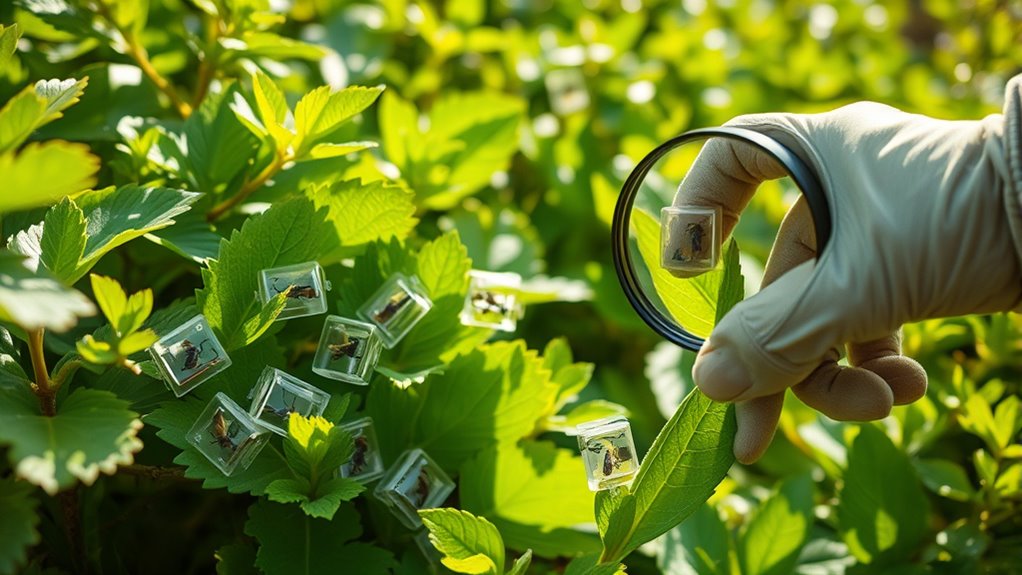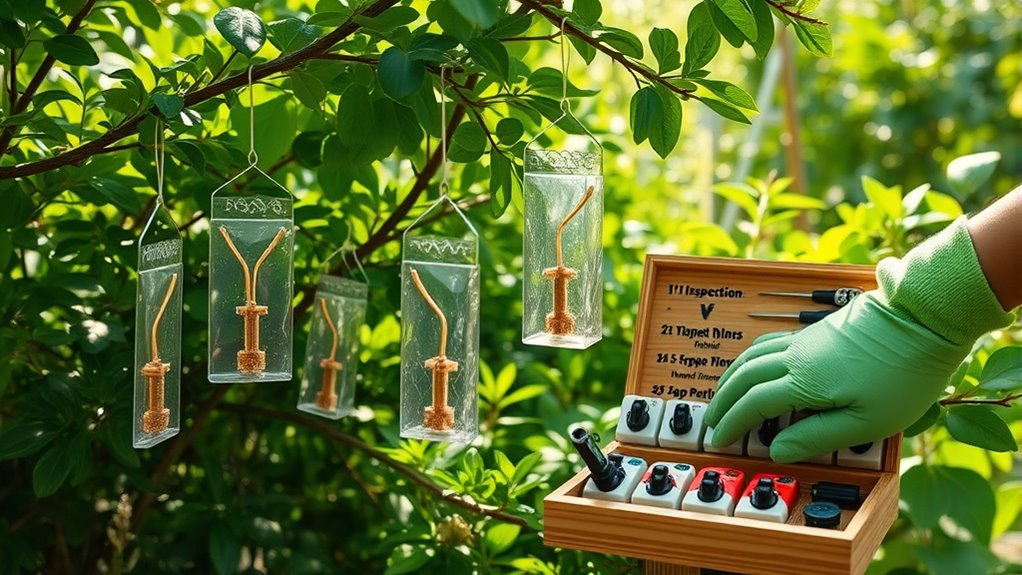To effectively monitor pests, you should strategically set traps in areas where pests travel or hide, such as entry points and along walls. Regular inspections—every few days or weekly—help catch signs early, allowing you to reset or replace traps as needed. Keep detailed records of trap activity, spot patterns, and adjust placements accordingly. Combining these practices with good sanitation boosts your chances of catching problems early—continue exploring to learn more about fine-tuning your approach.
Key Takeaways
- Place traps strategically near entry points, along walls, and in dark corners where pests are likely to travel or hide.
- Inspect traps regularly—daily or weekly—to detect early signs of pest activity and maintain trap effectiveness.
- Keep detailed records of trap results and inspection dates to identify activity patterns and high-risk areas.
- Combine trap monitoring with visual inspections and environmental sanitation to enhance pest detection and control.
- Adjust trap placement based on observed pest activity patterns to improve monitoring accuracy over time.

Have you ever wondered how to catch pest problems early before they become serious? Monitoring for pests is a vital step in keeping your home or business pest-free, and it starts with proper trap placement and consistent inspections. When setting traps, you want to position them strategically where pests are most likely to travel or hide. For example, near entry points, behind appliances, along walls, or in dark corners. Proper trap placement increases the chances of catching pests early, giving you a head start on managing the problem before it escalates. You should also consider the type of pest you’re targeting—different pests prefer different environments—so selecting the right trap and placing it correctly is essential.
Strategic trap placement near entry points, behind appliances, and in dark corners helps catch pests early.
Equally important is establishing a regular inspection frequency. Pest activity can fluctuate, so checking your traps at consistent intervals helps you stay ahead of any infestations. Depending on the pest and the severity of the problem, inspections might be daily, every few days, or weekly. Regular checks allow you to identify signs of pests early, such as droppings, damage, or the pests themselves. When inspecting, look for evidence of activity around traps, and don’t forget to replace or reset them as needed. Skipping inspections or infrequent checks can result in missing the initial signs of an infestation, making the problem harder to control later.
To maximize your monitoring efforts, keep a detailed record of your trap results and inspection dates. This record helps you identify patterns, such as peak activity times or specific areas where pests are more active. Over time, you’ll develop a better understanding of pest behavior and can adjust your trap placement accordingly. Remember, early detection is key to effective pest management. The sooner you notice pests, the easier and less costly it will be to eliminate them. Setting traps correctly and maintaining a consistent inspection schedule puts you in control, rather than reacting to a full-blown infestation.
In addition to physical traps, consider supplementing your monitoring with visual inspections and keeping your environment clean, dry, and less attractive to pests. Regularly monitoring for pests and maintaining good sanitation practices can significantly reduce the likelihood of an infestation. By staying proactive and vigilant, you’ll catch pest problems early, reducing the risk of damage and health issues. Regularly monitoring through proper trap placement and strict inspection frequency empowers you to maintain a pest-free space efficiently and confidently.
Frequently Asked Questions
How Often Should Traps Be Checked for Optimal Results?
You should check your traps at least once a week to guarantee effective trap maintenance and ideal results. Regular inspection frequency helps you catch pests early and prevents infestations from worsening. If you notice a high pest activity, increase the inspection frequency to every few days. Promptly replacing or resetting traps as needed keeps them functional and maximizes pest control efforts. Staying consistent with trap checks is key to keeping pests at bay.
What Types of Pests Are Most Effectively Monitored With Traps?
You can effectively monitor pests like rodents, insects, and flies with traps, as their behavior makes them attracted to bait or light. Proper trap placement is vital; place them near pest activity areas, entry points, or along walls where pests travel. Regularly checking traps helps you catch pests early, reducing infestations. Understanding pest behavior allows you to position traps strategically for maximum effectiveness and quick identification of issues.
Are There Eco-Friendly Trap Options Available?
Imagine a garden where pests are caught without harming the earth beneath your feet. Eco-friendly trap options like biodegradable traps and reusable bait stations exist, offering a gentle yet effective solution. These traps break down naturally or can be reused, reducing waste and chemical use. By choosing them, you protect your environment while keeping pests at bay, making your pest control efforts both sustainable and safe for your garden’s health.
How Do I Identify if a Trap Has Caught a Pest?
You can tell if a trap has caught a pest by checking for visible signs like insect bodies, droppings, or disturbed bait. Place traps where pest behavior suggests they’ll encounter them, such as along walls or near entry points. Regularly inspect traps, looking for movement or signs of pests. If you see pests or evidence, it’s time to take action and adjust trap placement if needed to target the pests effectively.
What Should I Do if I Find a Trapped Pest?
Imagine your trap is a tiny lighthouse guiding pests to their doom. Once you find a trapped pest, carefully identify it to determine if it’s a threat. Then, check trap placement—are they in high-traffic areas? Dispose of the pest promptly in a sealed bag, and reset the trap if needed. Regularly inspecting and adjusting trap placement helps keep pests away and your home pest-free.
Conclusion
Think of monitoring your space like a vigilant sentinel, just as Odysseus kept watch for dangers on his journey. Regularly setting traps and inspecting your environment guarantees pests don’t catch you off guard, letting you maintain a peaceful, pest-free home. Stay proactive, and you’ll keep those unwanted invaders at bay, preserving your sanctuary just like heroes safeguarding their domains. Remember, consistent vigilance is your best defense against unwelcome guests.









